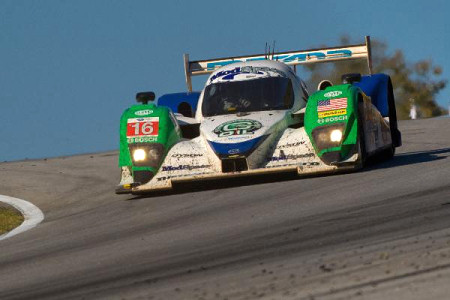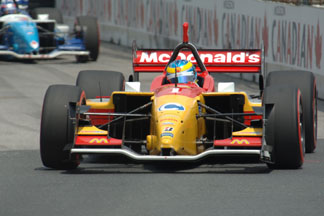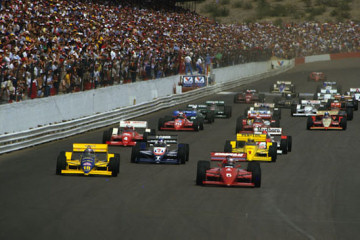The Way It Is/ End of the road for Lola?by Gordon Kirby |
 Sad news arrived last week with the announcement from Lola Cars that the renowned racing car builder has filed for bankruptcy, or 'administration' as it's called in the UK. Founded in 1958 by Eric Broadley in a tiny south London garage Lola built cars over the years for almost every conceivable category, Formula One included, and became one of the world's most successful and enduring production race car manufacturers.
Sad news arrived last week with the announcement from Lola Cars that the renowned racing car builder has filed for bankruptcy, or 'administration' as it's called in the UK. Founded in 1958 by Eric Broadley in a tiny south London garage Lola built cars over the years for almost every conceivable category, Formula One included, and became one of the world's most successful and enduring production race car manufacturers.
Lola's biggest successes came in America where Carl Haas Auto sold thousands of Can-Am and Formula 5000 cars, Indy cars, Formula Atlantics, Super Vees, Formula Fords and Sports 2000s. Among Lola's astonishing record of accomplishments are 181 individual Indy or Champ car victories, including three Indy 500s, as well as eleven CART or Champ Car titles and seven consecutive Formula 5000 and Can-Am championships between 1974-'80. This is not the first time Lola has been forced into bankruptcy. It happened before in 1997 after founder Broadley's unsuccessful final attempt to tackle Formula One with an underfunded, outdated car. The bankrupt company was bought in 1998 by Martin Birrane a successful London-based real estate developer from Ireland. Birrane enjoyed a long career as an amateur racing driver aboard a wide variety of cars including ten Le Mans 24 Hour starts. He's both a serious enthusiast who owns Mondello Park, Ireland's leading road circuit, and a tough-minded businessman. Birrane's property sales business is based in London and trades and develops property all over the United Kingdom, Ireland and Spain.  © Courtesy of Regis Lefebure, Dyson Racing But Birrane was determined to get Lola back in the winner's circle and a new Champ car was designed for 1998. By 2000 Birrane had been able to convince Carl Haas to return to the Lola fold and in May of that year Michael Andretti and Newman/Haas scored Lola's first Indy car victory in three and half years. Lolas went on to win seven CART races in 2000, ten in '01 and 16 in '02 as Cristiano da Matta took the championship for Newman/Haas. In 2003 Lolas won 17 of 18 Champ Car races with Paul Tracy and Jerry Forsythe's team taking the championship before the Lola B2/00 became Champ Car's de facto spec car and Sebastien Bourdais won four straight Champ Car titles with Newman/Haas's Lolas. The B2/00 was replaced in 2007 for what turned out to be Champ Car's final season by the American-made Panoz DP01 spec car. Losing its major American market was a serious blow to Lola, nor did Birrane have any luck building the spec car for the A1GP series which lasted only two years before going out of business. In recent years Lola has built a batch of cars for the Jim Russell School plus a handful of Formula 3 and Grand-Am cars. But the company has focused on building LMP1 and P2 cars working with Nissan, MG, Honda, Aston Martin, Dyson and others. Lola chassis have won the LMP2 category at Le Mans five times since 2000 and took last year's ALMS LMP1 and P2 constructor's titles and the LMP2 manufacturer's title in the European Le Mans Series. But P1 and P2 cars represent a small market nothing like the high volume of cars a constructor needs to build in order to make a successful business. Of course, over the last ten years the spec car plague has entirely overtaken every form of worldwide open-wheel racing below Formula One. As this phenomenon took hold Lola missed the boat perhaps because Birrane never embraced the spec car mentality. Nevertheless, as Birrane looked around for new markets he took on board that Dallara has established a near-monopoly of the global formula car market. It's never a good thing when one company dominates any industry. Monopolies are good for the monopolist, but not for the rest of the world. Yet today Dallara builds the cars for the GP2 series, each of the European, British, Italian, German and Japanese Formula 3 series, the GP3 series, the World Series by Renault and both the IndyCar and Indy Lights series.  © John Zimmermann Two years ago Lola joined competitors Swift, Bruce Ashmore and Delta Wing in making sales pitches to IndyCar to design and manufacture this year's new spec car. But all were rejected by IndyCar's Iconic committee in favor of Dallara. For Lola it was a serious blow leaving Birrane's company without any remaining market for open-wheel cars, a sad indictment surely of the great spec car plague. The first Lola was a front-engined sports/racer designed, built and raced by a young Eric Broadley. The car was quick and elegant and Broadley immediately found a market for small sports/racers and Formula Junior cars. In 1962 Broadley designed his first Formula One car for John Surtees and Roy Salvadori to race for the Bowmaker team. Surtees qualified his Lola on the pole for its debut at the Dutch GP in '62 and finished second in the British and German GPs but Surtees moved on to Ferrari in 1963 and the first Lola F1 project came to an end. A few years later Lola would build the chassis for Honda's 1967 Italian Grand Prix-winning car driven by Surtees. Lola also built the chassis for Graham Hill's Cosworth-powered F1 cars in 1974 and '75, the Lamborghini F1 cars in 1989 and '90, and the ill-fated Ford/Zetec-powered 1997 F1 car. But back in 1962 Broadley also designed and built the sleek Lola GT and the design rights to the car were bought by Ford forming the basis of the legendary Ford GT40 and mk II and mk IV Le Mans cars. The income from Ford helped Broadley expand Lola into becoming a serious manufacturer of Group 7 or Can-Am cars and Formula 5000 cars. The Lola T70 appeared in 1965 and John Surtees won the following year's inaugural Can-Am championship aboard a T70 while Mark Donohue also scored Penske Racing's first three victories that year driving a T70. The elegant T70 was a mainstay of the early Can-Am series and I'll always remember Martin Birrane's boyish enthusiasm when he showed me the perfectly made replica of Surtees's 1966 Can-Am-winning T70 at Quail Hollow during the Monterey Historics a few years ago. It was during the mid-sixties of course that Carl Haas became Lola's North American sales agent and distributor. Chicago-based Haas was Lola's man in America for forty years from 1966-2006 with a three-year break between 1997-'99 while Newman/Haas developed and raced Swift Indy cars. Haas was the driving force behind Lola's long line of American successes in Can-Am, Formula 5000 and Indy cars as well as SCCA and IMSA sports car racing.  © Paul Webb/LATUSA A few years later Haas's team went on to win seven consecutive Formula 5000 and Can-Am championships between 1974-'80 with Lola chassis. Brian Redman drove a series of Haas/Hall Lola-Chevy T332 Formula 5000 cars to three straight championships in 1974, '75 and '76 followed by four successive Can-Am titles won by Haas Lola T333 and T530 Can-Am cars driven by Patrick Tambay, Jacky Ickx and Alan Jones. Meanwhile Lola built its first Indy car, the T90, in 1966 and Rodger Ward drove an Offy-powerd T90 to score the marque's first Indy car win at Trenton in April of '66. The following month Graham Hill recorded Lola's first Indy 500 win driving John Mecom's Ford-powered T90 while Al Unser won seven other USAC Championship races in 1968 and '69 driving a Lola-Ford for Vel's Parnelli Jones. In '69 Roger Penske made his first Indy 500 entry with a Lola-Offy co-entered with Carl Haas and driven by Mark Donohue. The following year Donohue drove Penske's Lola-Ford to second place at Indianapolis behind Al Unser's Lola-based PJ Colt-Ford. The next Lola Indy car, the T500, didn't appear until 1978 and although it wasn't particularly quick the car made a big mark as Al Unser became the only Indy car driver to win three 500-mile races in one year driving a T500-Cosworth for Jim Hall's Chaparral team. Lola's next Indy car, the T700, appeared in 1983 driven by Mario Andretti for the fledgling Newman/Haas team. Andretti won two races with the recalcitrant T700 in '83 but an all-new Lola, the T800, was designed by Nigel Bennett for 1984 and Mario swept to the CART championship, winning six races. With Newman/Haas leading the way Lola became a major player in Indy car racing winning many races through the eighties and nineties. Bobby Rahal won the 1987 CART championship driving Lola-Cosworths for the Truesports team; Al Unser Jr. took the 1990 CART title driving Lola-Chevies for Rick Galles; Michael Andretti won the '91 CART title driving Lola-Chevies for Newman/Haas; Rahal drove Lola-Chevies to win the '92 CART championship in his first year as an owner/driver; and Nigel Mansell won the '93 CART title for Newman/Haas aboard Lola-Ford/Cosworths. In 1988 Bruce Ashmore replaced Nigel Bennett as Lola's chief Indy car designer and his record speaks for itself. But in 1994 Ashmore was wooed away from Lola by Adrian Reynard and over the next few years Reynard's Indy cars began to outperform Lola's products. Lola failed to win a single CART race in 1997, '98 and '99 as the customer base dwindled and Lola struggled through its first bankruptcy. During these years Newman/Haas developed and raced Swift Indy cars but Martin Birrane convinced Newman/Haas to return to the Lola fold in 2000. Chip Ganassi also bought a fleet of Lolas and the two teams combined to win seven races in 2000 and in 2002 Cristiano da Matta won CART's championship for Newman/Haas driving a Toyota-powered Lola.  © Paul Webb The B2/00 proved to be tremendously reliable, durable and safe. By the end of '06 when the B2/00 was retired many of the cars had recorded more than 15,000 racing miles. Lola built eighty-one of those cars between 2000-'05. For a few of those years the teams were buying fleets of new cars every season, as they had for years. But then Toyota and Honda pulled out of CART and the series began to implode. In 2003, CART or Champ Car switched to a Ford/Cosworth spec engine formula, but without the backing of major manufacturers and dwindling interest in the series none of the teams had the resources to buy new cars. Production of the B2/00 trailed off and finally came to a halt in 2005. The Lola marque survived and thrived while many other well-known English production racing car constructors like March, Ralt and Reynard came and went after relatively short, sometimes fitful lives. Of course, a lifespan of 50 or more years is extremely rare for any race car builder. It's interesting to reflect on a partial list of American Indy car builders that have come and gone over the decades--Duesenberg, Miller, Kurtis, Watson, Kuzma, Epperly, Gerhardt, Eagle, Parnelli, Penske, Wildcat and Swift. So goes the race car business.... One of Lola's failings was that the company was never able to establish much longterm sales success in Europe's primary open-wheel categories--F3, F2, F3000, etc. Over a long period of time Lola was beaten in these key categories by March, Ralt and Reynard and finally thrashed by Dallara. In recent years Lola made a serious effort to diversify beyond racing with Lola Composites expanding into defence, aerospace and renewable and wind energy industries. But it appears not to have been enough. Swift in California has also diversified and is now largely out of the racing business while Panoz in Georgia is the likely constructor of Delta Wing production cars. Will Lola be able to reorganize and emerge as a viable race car builder? Unlikely, it appears. After the administration process is complete it will be interesting to hear what Martin Birrane has to say about Lola's struggle to survive. |
Auto Racing ~ Gordon Kirby Copyright 2012 ~ All Rights Reserved |
